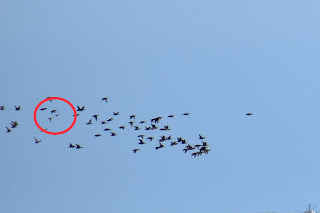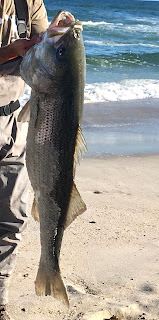Fall Day at the Beach - 11/3/22
Yesterday was a pleasant fall day, a perfect day actually to spend on the beach. One of my favorite activities is taking a leisurely drive along the beach at Island Beach State Park and with the day to myself, that’s what I did. Inland birding was rather slow, and an earlier walk at Reeds Road, one of the park’s birding hotspots, also did not produce many bird highlights. So, as a sports fishing beach buggy permit holder, I entered the beach at the Gilikins entry point at the park’s northern section. Now that the summer tourist season is over, the bathing beaches are open to beach buggy vehicles, and I can drive the beach for nearly seven miles to the north jetty at Barnegat Inlet.
After a short lull the last couple days, the sea duck and bird migration flight along the Atlantic corridor was back in action. Waves of scoter flocks were traveling south, each flock containing probably anywhere from 50 to maybe 200 birds each. I conservatively estimated the total number at 2000 birds for the few hours I was watching. The flocks traveled past between a couple hundred yards off the beach and out to the horizon. I noticed all three scoter species at times: surf, black and white-winged. Flying higher than the scoter flocks were dozens of cormorant flocks in similar numbers. The cormorants were mostly double-crested, but I’m sure there were some greats mixed in as well. Mixed in with the passing scoter flocks were other ducks, such as northern pintails, greater (and maybe lesser) scaup, and green-winged teal. The teal are much easier to pick out because of their tiny size compared to the other ducks. I did not notice any black ducks, wigeons or wood ducks but they are likely migrants too.
I noticed numbers of loons moving in also, both common and red-throated. Soon their numbers will pick up and also be in the thousands. Many gannets were all along the stretch of the beach, near and far, representing various ages and stages of plumage. Soon too there should be thousands of them moving through. What a sight that is as hundreds plunge dive offshore, feasting on the bait fish also moving through the area.
Down at the inlet, there were still brown pelicans hanging around feeding on the schools of bunker. I counted 43 pelicans in all, much less than the 200-plus around a month ago but still an impressive amount. I saw a seal swimming in the surf near the beach, but it disappeared before I could get its photograph. When the temperatures in the area drop later in the season, they will become more common and likely be seen hauled out of the water on an outcropping of rocks near the back of the inlet. Along the way down to the inlet, shorebirds littered the beach. Dunlin numbers steadily increasing and black-bellied plovers still numbering in the dozens. A group of 33 semi-palmated plovers split resting and foraging activities near the water. In one group of black-bellied plovers, a lone dowitcher stood with its head tucked under its wing. Ebird suggests it to be a long-billed, since it considers short-billeds to be rare now. The most reliable way to separate the two is by voice. Since I didn’t want to disturb this one, and doing so wouldn’t guarantee it would vocalize, I listed it as a long-billed/short-billed.
On my drive back north up the beach I was happy to see the acres of bunker that were all along the coast, yet amazed that none of the fishermen were catching anything (including myself, but I wasn’t trying either). Not soon after myself pondering, I saw one fisherman land a stunning 20-plus pound striped bass. He carefully extracted the hook from the fish’s mouth, took the obligatory sport fishing photos and successfully released it back into the water. Fishing regulations only allow one striped bass per day that measures between 28 and 38 inches. His fish was well over 38 inches.
The treat of the day however was just before I was about to exit the beach, I saw a humpback whale surface not too far from shore. I stopped and watched this amazing creature as it even breached probably about a dozen times during the hour or so I observed it. Getting a photo of this spectacular sight was frustrating. You never know if and when a whale is going to breach or even where it will pop up. A few times at a distance I saw fish flying out of the water probably trying to escape the enormous gulp of the hungry mammal. Luckily, I managed a couple pictures of its acrobatic feats before it eventually moved away and out of sight. These are the days that keep me coming back.
The hump and fluke of a humpback whale. © S. Weiss
















Comments
Post a Comment